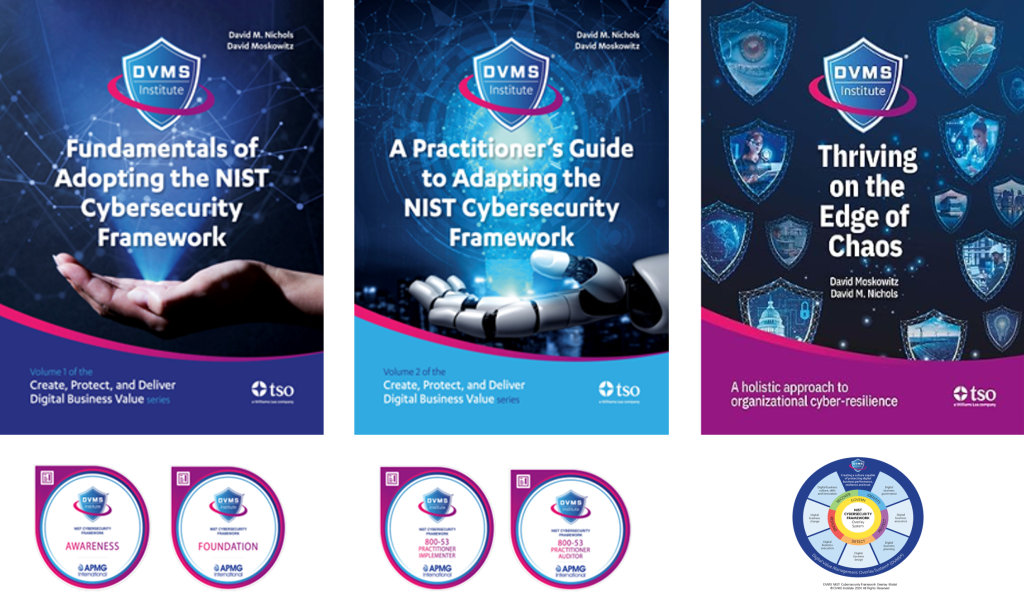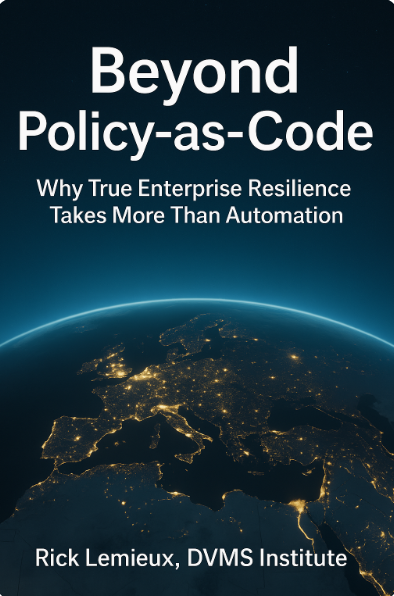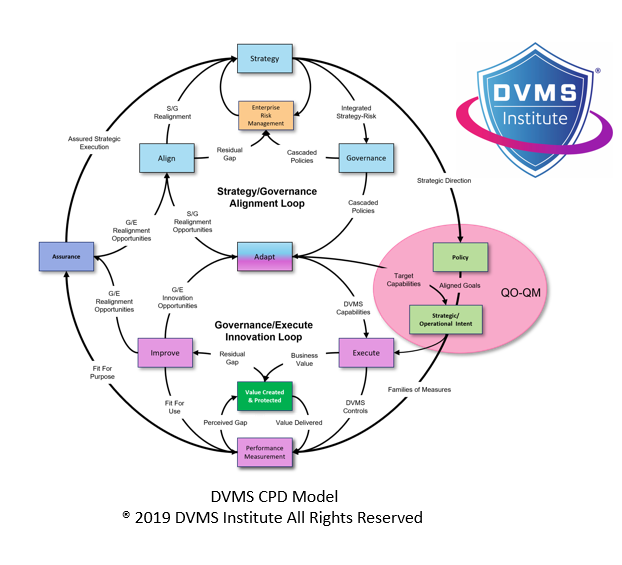Solving the Policy-as-Code Challenge
Rick Lemieux – Co-Founder and Chief Product Officer of the DVMS Institute
In today’s digital-first economy, organizations face relentless pressure. They must protect complex infrastructures, comply with regulations, and deliver products and services more quickly than ever. To address these challenges, many have adopted Policy-as-Code (PaC). This groundbreaking approach moves security and compliance from static documents to flexible, automated controls integrated directly into DevOps pipelines.
With the rise of advanced tools like Prisma Cloud, Open Policy Agent (OPA), Sentinel, and Conftest, enterprises now have unprecedented abilities to automate policy enforcement. However, despite these innovations, a hard truth remains: automation alone does not ensure resilience.
While PaC strengthens technical enforcement, it often leaves organizations struggling at the governance and cultural levels. The result is that many enterprises face a new kind of complexity that cannot be solved by code or tooling alone.
This is where the Digital Value Management System® (DVMS) becomes crucial. Instead of replacing current frameworks or methods, DVMS is a systems-thinking overlay that helps organizations turn their automated policy efforts into lasting enterprise-wide value.
The Hidden Gaps in Policy-as-Code
At its best, Policy-as-Code provides obvious benefits. It minimizes manual configuration mistakes, enhances auditability, and speeds up delivery without compromising security. However, in real-world use, many organizations face unseen gaps.
Rules spread across teams without unified oversight. Developers, under pressure to meet deadlines, bypass security controls they see as strict or out of sync with real-world needs. Meanwhile, security and compliance teams struggle to keep up, causing tensions that spread through the delivery process.
Without strategic alignment and cultural integration, Policy-as-Code can descend into what might be called policy sprawl — a well-meaning effort hampered by fragmentation, resistance, and unintended consequences.
The DVMS Overlay: Aligning Strategy, Governance, and Execution
The DVMS provides something rare in today’s technology scene: a way that links the boardroom to the loading dock, making sure that automated controls support not only technical needs but also strategic business goals.
Instead of adding another framework or bureaucracy, DVMS integrates existing tools, processes, and governance structures. It helps leaders identify where capability gaps are—whether in technology, governance, or human behavior—and offers a structured way to align intent with action.
Through models like Create, Protect, Deliver (CPD) and the MVC Overlay, DVMS enables organizations to understand how security controls, business goals, and delivery pressures interact. This helps balance protection with delivery needs, preventing over-securing that could hinder agility.
In practice, this means that when a new access control rule is introduced, its impact is evaluated not only for security benefits but also for its potential to delay product launches or disrupt services. DVMS facilitates a level of cross-functional dialogue and decision-making that is rarely achieved through tooling alone.
Growing with Purpose: The DVMS FastTrack™ Path
What sets DVMS apart is not just what it does, but how it helps organizations evolve. Its FastTrack™ approach provides a phased path to maturity, starting with establishing baseline code policies, moving through automated enforcement, expanding into integrated DevSecOps workflows, and ultimately advancing to AI-driven, adaptive policy models.
This gradual path ensures that Policy-as-Code adoption grows alongside organizational capability, avoiding the pitfalls of “big bang” transformations that overwhelm teams and systems.
Addressing the Human Factor
Perhaps most importantly, DVMS recognizes that technology failures are often caused by human behavior. It treats culture as a measurable risk factor — a rare approach among governance models.
Through constructs like the 3D Knowledge Model, leadership teams gain insight into where behaviors might resist or weaken policy goals. DVMS offers tools not only to design better systems but also to shape mindsets, practices, and shared responsibilities that make those systems sustainable.
In this way, Policy-as-Code moves from being viewed as a bottleneck or an imposed control to becoming a shared enabler of value creation and security — embraced by developers, security engineers, operations teams, and business stakeholders alike.
The Power of Measurement and Feedback
One of the most exciting promises of Policy-as-Code is the ability to measure what was once invisible. But measurement without alignment is noise.
DVMS introduces structured models like Goal-Question-Metric (GQM) and Question Outcome–Question Metric (QO-QM) to ensure that what is measured truly matters. Instead of just focusing on technical metrics, organizations monitor the impact of policy efforts on business results — from how often policies are overridden and why to how quickly they meet regulatory requirements.
This ongoing feedback loop turns compliance from a static task into a dynamic process of governance assurance and continuous improvement.
Building Resilience at Every Level
When organizations integrate Policy-as-Code with the Digital Value Management System, they unlock more than automated security. They establish the foundation for true enterprise resilience.
Governance becomes practical, as boardroom strategies effectively translate into frontline practices. Automation becomes a strategic tool, enhancing not only technical compliance but also business agility. Culture shifts from causing friction to fostering adaptability and innovation.
In this integrated model, security is no longer just a technical or compliance task. It becomes a core pillar of digital value creation, empowering organizations to innovate confidently, adapt quickly, and succeed amid constant change.
Ultimately, the future isn’t just about writing better code or enforcing stricter policies. It’s about developing human and technical systems that can handle uncertainty, accept complexity, and turn disruptions into opportunities.
That’s the promise of combining Policy-as-Code with DVMS—and it’s a promise that forward-thinking organizations are eager to embrace.
About the Author

Rick Lemieux
Co-Founder and Chief Product Officer of the DVMS Institute
Rick has 40+ years of passion and experience creating solutions to give organizations a competitive edge in their service markets. In 2015, Rick was identified as one of the top five IT Entrepreneurs in the State of Rhode Island by the TECH 10 awards for developing innovative training and mentoring solutions for boards, senior executives, and operational stakeholders.
In today’s digitally driven economy, cyber disruptions are no longer an “if” but a “when.”
The DVMS Institute’s Certified Training Programs teach organizations the skills to build a Holistic and Culture-Aligned Overlay System capable of coordinating Adaptive, Governance, Resilience, and Assurance actions across a Complex Digital Ecosystem.
Achieving true cyber resilience across a complex digital ecosystem requires seamless alignment between organizational Strategy, Governance, and Operations, underpinned by a culture dedicated to sustaining and continuously innovating organizational digital value.

The DVMS positions cyber resilience as a strategic, enterprise-wide capability powered by the Institute’s CPD, Z-X, and 3D Knowledge models.
This systems-based approach to cyber operational resilience demands active engagement from all members of the Digital Ecosystem, with each member playing a distinct role in proactively identifying and mitigating the systemic risks that threaten digital business operations.
This adaptive, forward-looking approach to Governance, Resilience, and Assurance (GRA) positions businesses to:
- Maintain Operational Stability Amidst Constant Digital Disruption
- Drive Agility and Trust Across Your Digital Ecosystem
- Satisfy Critical Regulatory and Certification Requirements
- Leverage Cyber Resilience as a Competitive Advantage
DVMS Explainer Videos
- Architecture Video: David Moskowitz explains the DVMS System
- Case Study Video: Dr. Joseph Baugh Shares His DVMS Story.
- Overlay Model – What is an Overlay Model
- ZX Model – The MVC’s that power operational resilience
- CPD Model – Adaptable governance and assurance
- 3D Knowledge Model – Enabling holistic organizational learning
- FastTrack Model – A phased approach to cyber resilience
Digital Value Management System® is a registered trademark of the DVMS Institute LLC.
® DVMS Institute 2025 All Rights Reserved



